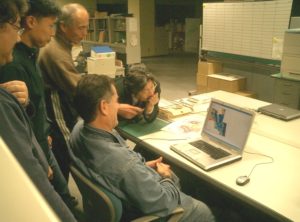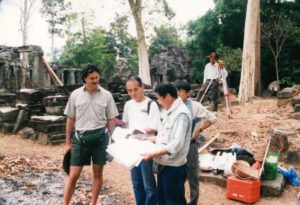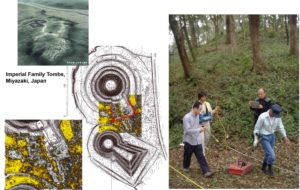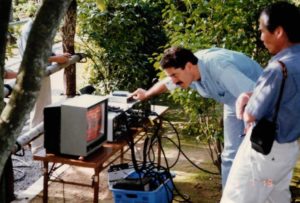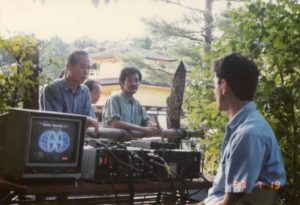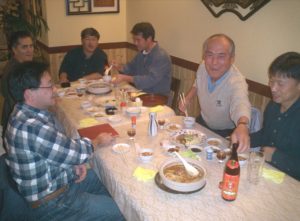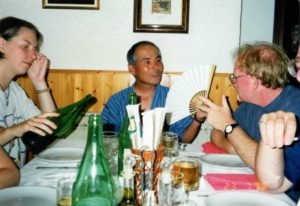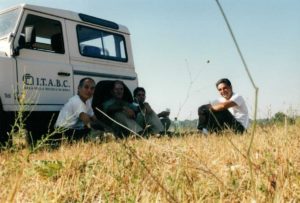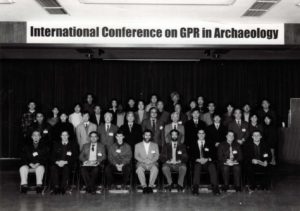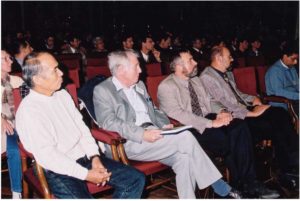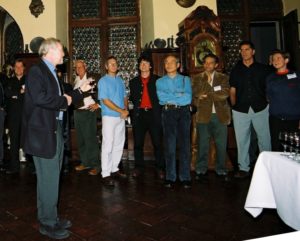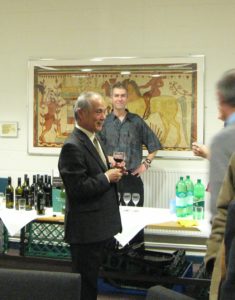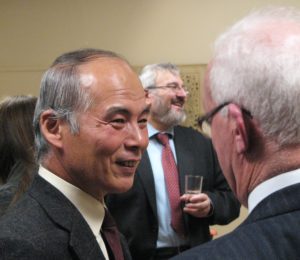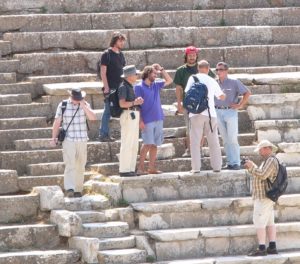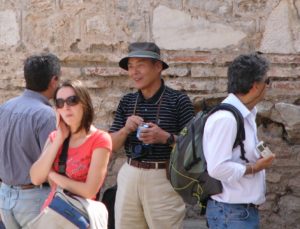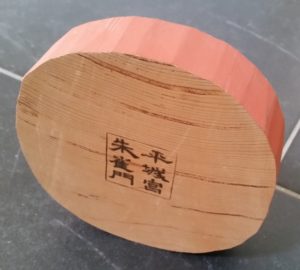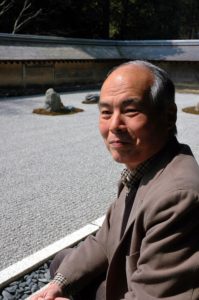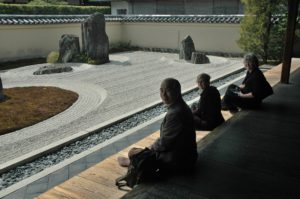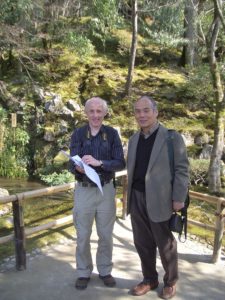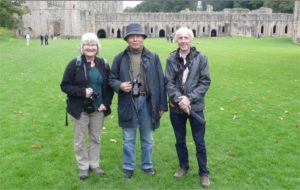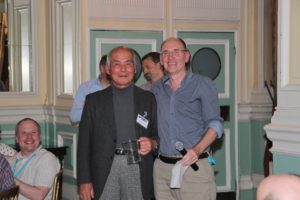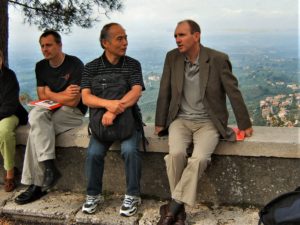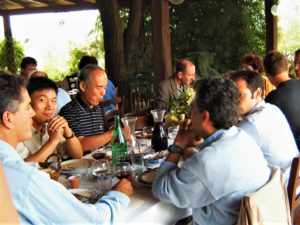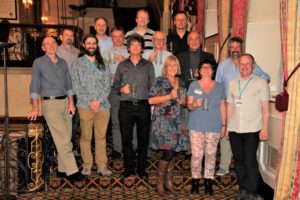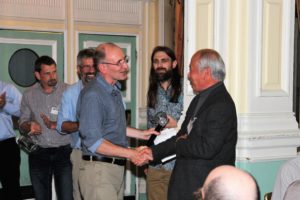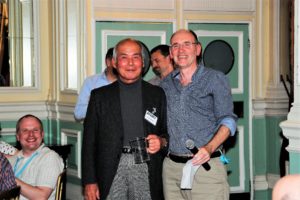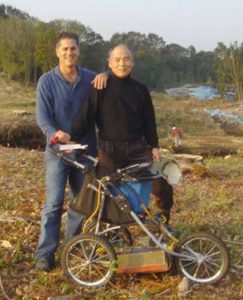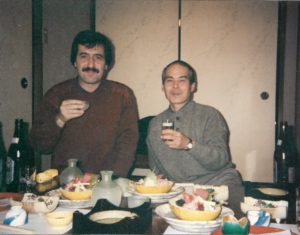It is with immense sadness that we inform you of the death of Yasushi Nishimura on 12 March 2020. He has championed archaeological geophysics not only in Japan and South East Asia, but also globally through participation in many international workshops and projects. His role as a mentor has led many of us ‘on the right path’ and helped to progress new ideas in archaeological prospection. Together with Dean Goodman he demonstrated how GPR can revolutionise the view of the subsurface at a time when only few thought this would ever be possible. He has been an ISAP Honorary Member since the beginning in 2004.
We will sorely miss him.
Chris Gaffney (Chair) and Armin Schmidt (Honorary Secretary), 13 March 2020
Information
We have to inform everyone of the sad news that our visiting researcher Mr. Nishimura Yasushi passed away today. He was the director of our laboratory and leader of archaeological prospection in Japan.
Future plans will be announced later…
KANEDA Akihiro
Nara National Research Institute for Cultural Properities.
Centre for Archaeological Operations.
Kaneda-a3t@nich.go.jp
A colleague, mentor and friend
With great sadness we have learned that Yasushi Nishimura has passed.
I first met Nishimura San in 1990. We had just opened a small laboratory in archaeological geophysics under the University of Miami Florida in Ishikawa Prefecture and Nishimura San invited us to work jointly with his institute – the world renown Nara National Cultural Properties Research Institute. His research group, along with Dr Hiroyuki Kamei at Chiba University, at the time were already working on magnetic, resistivity and GPR imaging at archaeological sites. Nishimura San along with Kamei San had the first publication that I ever encountered on GPR times slices –Nishimura, Y and Kamei, H (1990, Proceedings of the 27th International Conference on Archaeometry, Heidelberg). Beginning in the summer of 1990 Nishimura San and our small lab along with Koji Tobita began doing joint surveys all over Japan and continued through our last survey together in 2015 in Kyushu. The joint work happened alongside with Hiromichi Hongo and Noriaki Higashi who were archaeologists and curators at the Saitobaru National Burial mounds.
Nishimura was directed early on by the Ministry of Cultural Affairs in Japan to begin joint research with a number of international organizations, including many projects with the Smithsonian, the National Park Service (both USA), the Consiglio Nacionale delle Ricerche (Italy), University of Bradford (UK) and the Korean Cultural Research Institute amongst others. I was the lucky benefactor to be able to accompany Nishimura San on so many of his joint projects outside of Japan. I learned more about the United States and traveled to so many remote locations in the mid-west that I would never have had an opportunity had it not been for Nishimura San. On his joint work with CNR in Italy we collaborated on survey field seasons that lasted over 12 years with Dr. Salvatore Piro on many important sites including the Villa of Trajan and the Forum Novum projects. In Korea, Nishimura San was not only a pioneer to open up joint work with Dr. Hyun dok Oh, but to act as an ambassador to bring countries closer together through scientific dialog.
For those that encountered Nishimura they always felt his warmth. He had a very “international” demeanor and he truly enjoyed all his colleagues over the world. I think his consciousness was one of a man that really did not have borders, but he still knew very well how to work in the system that he was born into in Japan. He was very respected as the most influential scientist in his field of archaeological geophysics. Everyone in Japan knew of his international likeability and even after retiring from the Nara Institute he was given a prominent position as a director of UNESCO in Nara which was his position until last year.
For me personally, Nishimura San brought to me an awareness of cultural appreciation that I would never have had exposure to. He showed so much patience for a guy that really was culturally uninclined and helped me open up my eyes to many beautiful experiences in our times of travel and work together. To write any words about my mentor seems insufficient. Nishimura San was my colleague, mentor and a friend. He will always be in my heart and I will miss him forever.
A lasting impression
In 1995 I had the opportunity to spend three weeks in the Nara National Cultural Properties Research Institute, Japan, hosted by Nishimura San. This was by far my most memorable research visit, especially as Nishimura San had taken it upon himself to introduce me to Japanese archaeology and culture. It started with Japanese food (and how to eat it), included visits to many temples, archaeological sites and museums, and also exposed me to fancy Japanese archaeological excavation practices: workers with white gloves shifted spoil onto mobile conveyor belts that transported everything to dedicated sieving areas – like magic. Similarly, our joint magnetometer surveys (also requiring white gloves) were meticulously planned, including a metal detector survey to clear modern rubbish prior to our start. My amazement about all these wonders must have looked quite naive, but Nishimura San generously ignored this, and instead made me feel at home in Japan through this fast-paced immersion. He instilled in me a lasting admiration for Japan.
Not only was he highly respected for his archaeological and archaeological geophysics knowledge, but also for his innate ability to mentor students, colleagues and friends to strive for high standards in their professional work. I know many who always looked for his approval of their latest fieldwork or research output and I certainly was always relieved when he commented positively on my results, for example during conferences.
He attended nearly all International Conferences on Archaeological Prospection and organised the second one (ICAP1997, see also the book of abstracts) in Ise, Japan. This was a considerable step up in professionalism from the first conference that we had put together in Bradford and certainly set a standard for subsequent meetings. When a special event was organised in 2006 to celebrate Arnold Aspinall’s 80th birthday he took it upon himself to come to Bradford to visit and celebrate his friend. Arnold was very touched that colleagues travelled even from Japan, just to celebrate with him.
While initially mainly using magnetometer surveys, as they were well suited to the investigation of medieval kiln sites, one of his interests, he soon realised the powerful contributions that ground penetrating radar (GPR) could make to archaeological prospection. Starting with analog printouts along transects, his work with Dean Goodman resulted in new digital timeslices that provided map-views of the ground, which archaeologists were able quickly to use for their own research. He also forged close links with the Japanese equipment manufacturer Oyo, where I was introduced during my visit to a team, specifically assembled to advance archaeological investigations. Similarly, his links with the research group of Dr Hiroyuki Kamei at the Tokyo Institute of Technology allowed him to stimulate research in archaeological prospection by presenting the geophysical engineering team with always new challenges. Having been introduced to this research group during my research visit, we were able to undertake joint research in the UK, mainly looking at medieval metalworking sites.
Nishimura San, like Arnold Aspinall, encouraged high standards through generosity and kindness and I and many others have greatly benefitted from his mentoring. He will be remembered very fondly.
A kind man
I had the privilege of knowing Nishimura San personally. He was a very kind man and I would like to tell a personal story: Several years ago, my wife and I visited Japan and we were walking around in Nara. Suddenly I saw the street name of Nishimura San’s office. Spontaneously we decided to go to his office and met him there indeed. He was about to move his office. Nevertheless, he immediately stopped his work and gave us a personally guided tour of Nara during a whole day. What a nice touch! I still have a slice of a tree used for the building of the houses he gave me at the end of the day…
Always generous
In 2008 our daughter was studying Japanese in Tokyo as part of her degree course. My wife, Kath, and I went out to visit her and when we told Yasushi of our visit and our love of the gardens in Japan he insisted on giving us all a personal guided tour of gardens and temples in Kyoto, including a very peaceful time in Ryoan-ji (first picture) and a fascinating in-depth guided tour around all of the nationally important ACCU Nara complex. He also arranged a special Japanese tea ceremony for us in beautiful secluded gardens. Forever extremely generous, he did not let us leave without treating us to a wonderful traditional Japanese banquet, with foods of such glorious colours and tastes that even Yasushi did not recognise some of them! For us, Japan equals Yasushi, and his generous and friendly spirit will be sadly missed.
The passing of a great friend
It was with great sadness that I heard of the the death of Yasushi Nishimura. When, in 2005, ISAP bestowed Honorary Membership for the first time, Yasushi’s name was agreed without any disagreement. He was the perfect ambassador for our discipline. In ISAP NEWS I wrote: ‘Up until his recent retirement from the Nara National Cultural Properties Research Institute, Dr Nishimura was the only national government employee responsible for directing research activities related to developing the field of archaeological prospection in Japan. His interests are well illustrated by his numerous international and domestic publications, which are largely dedicated to research in archaeological prospection. Dr Nishimura has been an excellent ambassador for our discipline, working all over the world with academics and practitioners from a host of countries. Notable surveys include Angor Wat in Cambodia, Wroxeter in England, the Villa of Traianos and the Forum Novum in Italy. He has overseen and directed several university projects to produce new geophysical equipment which are dedicated solely to the purpose of archaeology, including continuous wave radar and a vector component magnetometer. Somehow during this intensive work load he cofounded the Japanese Society for Archaeological Prospection and has served as President of the organization since its inception. Dr Nishimura is currently working for the Asian Cooperation Center which is a branch of UNESCO in Nara Japan, where he is responsible for introducing and teaching archaeology and human history to students from across all the countries in Asia. Dr Nishimura has always been too modest when discussing his contribution to our subject. In typical fashion he responded to the nomination ‘I believe that if I am to deserve such a nomination, that it has only come with the assistance and support of many colleagues and friends, and for this I am very thankful’.’ I think it is fair to say that all who met Yasushi will remember his modesty when discussing his achievements, as well as his generosity of time to those who were starting off on the prospecting journey. I first meet him some time in the late 1980s; I was a postgraduate student and he visited Arnold Aspinall’s laboratory where I was studying. We had a great time – we set up experiments in the laboratory and went out on survey to collect field data. He was always immaculately dressed and even the ‘boiler suit’ that he then wore for any kind of work (field or lab) was pristine. I doubt if he thought that of my attire, but he would never have commented about my dress sense! He was always the diplomat and the politest person I have ever met. We also shared a drink or two during his stay and I will always think of those happy times. I shall raise a glass to a friend, a kindred spirit for our discipline and a loyal member of ISAP.
Encouragement
We would like to record our gratitude to Yasushi Nishimura for encouragement in applying GPR in Greek archaeology. The late 1980s when he visited us in Greece was a critical time in that development. Stavros Papamarinopoulos’ NATO Science for Stability funded project (GR-Geotech), which had a GPR component, had just begun and survey was underway at ancient Mantineia. One of us, GT, having obtained a GPR at Thessaloniki University in 1992, made a productive visit to Yasushi Nishimura at Nara in 1996 (see photo). For RJ, it was sufficient to appreciate the technique’s potential from the graphics reproduced in his attractive colour booklets – in Japanese of course!

